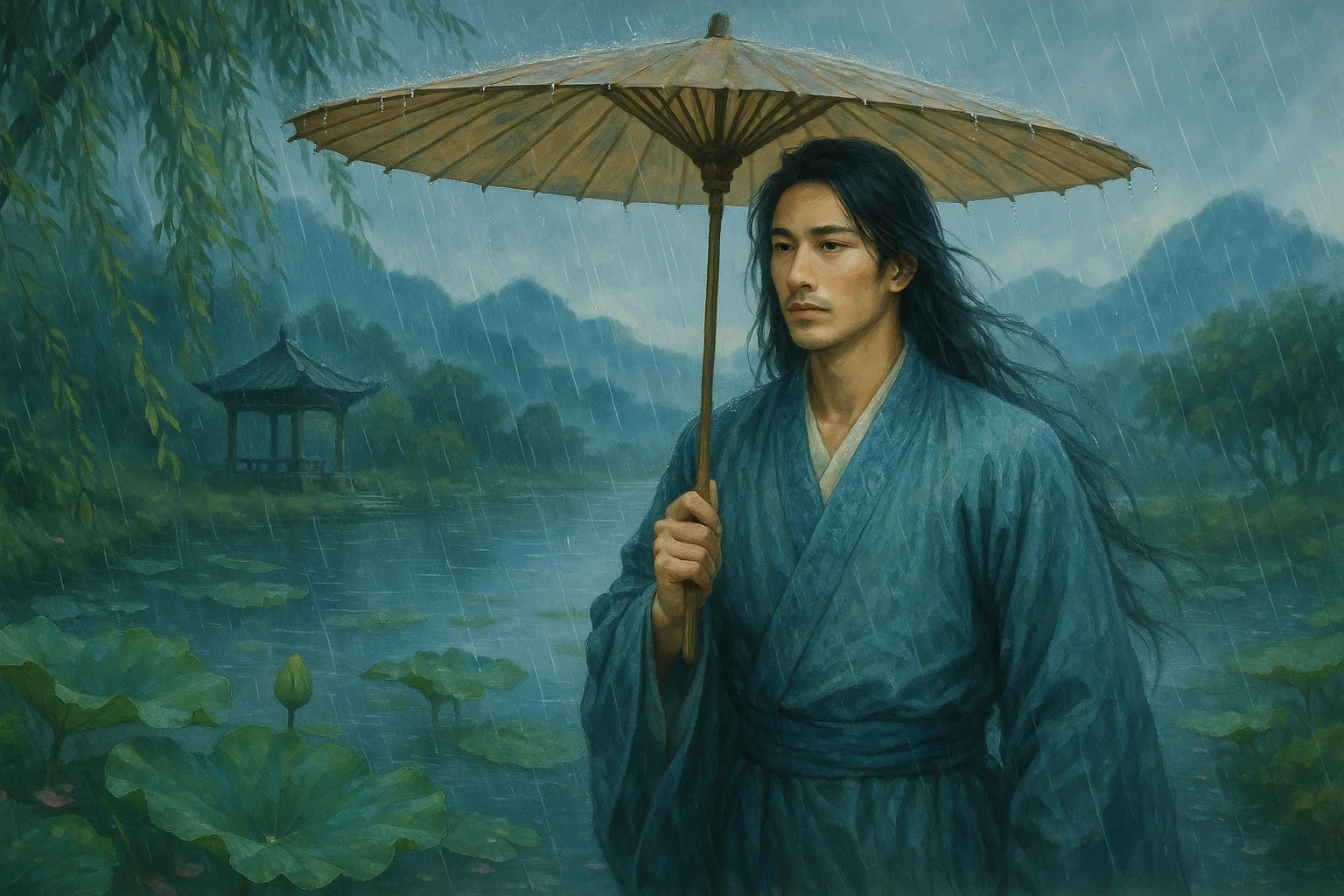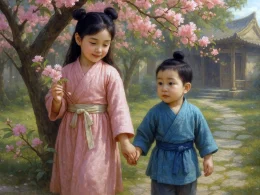At Southern Bank we part in spring’s embrace,
With cups of wine from Yang Pass’ farewell grace.
My belt, though heartless, slackens in despair,
As grief weighs down the parting pair.
Sorrows drown deeper than the bitter sea,
And regrets chase peaks afar from me.
Now hear the heartbreak gibbons’ cry—
Like geese shot down from echoing sky!
Original Poem
「生查子 · 人分南浦春」
吕本中
人分南浦春,酒把阳关盏。
衣带自无情,顿为离人缓。
愁随苦海深,恨逐前峰远。
更听断肠猿,一似闻弦雁。
Interpretation
This short lyric by Lü Benzhong, a Southern Song poet well-acquainted with the pains of separation, distills the essence of farewell into twenty characters. Drawing on classical parting motifs—the Southern Bank (南浦) and Yang Pass (阳关)—the poem transforms physical objects into emotional barometers, measuring the weight of sorrow through a loosened belt and echoing cries of wildlife. Though the subject of parting remains unnamed, the verse’s emotional precision suggests personal experience rather than literary exercise.
Upper Stanza: "人分南浦春,酒把阳关盏。衣带自无情,顿为离人缓。"
Rén fēn Nánpǔ chūn, jiǔ bǎ Yángguān zhǎn. Yīdài zì wúqíng, dùn wèi lí rén huǎn.
We part at Southern Bank amid spring’s bloom,
raising Yang Pass cups in toast.
Even this belt—heartless by nature—
suddenly slackens for the parting soul.
The stanza opens with two classical farewell symbols: Southern Bank (南浦), a riverside parting site since the Chuci, and Yang Pass (阳关), immortalized by Wang Wei’s farewell poem. The juxtaposition of "spring’s bloom" (春) with parting deepens the sorrow—nature’s renewal contrasts with human separation. The "slackening belt" (衣带缓) is a masterstroke: an inanimate object seemingly responds to grief, embodying the physical toll of sorrow. Historically, loose belts symbolized weight loss from pining, here made visceral.
Lower Stanza: "愁随苦海深,恨逐前峰远。更听断肠猿,一似闻弦雁。"
Chóu suí kǔhǎi shēn, hèn zhú qián fēng yuǎn. Gèng tīng duàncháng yuán, yīsì wén xián yàn.
Sorrow sinks deep as the Sea of Bitterness,
regret chases distant peaks beyond reach.
Then comes the gut-wrenching gibbon’s wail—
like geese startled by a bowstring’s twang.
The lower stanza amplifies grief through natural metaphors. The "Sea of Bitterness" (苦海), a Buddhist term for life’s suffering, merges with "distant peaks" (前峰) to map sorrow’s boundless terrain. The "gibbon’s wail" (断肠猿) alludes to the Three Gorges’ mournful gibbons, whose cries were said to tear travelers’ hearts. The closing simile—"geese startled by a bowstring" (闻弦雁)—references a legend where wounded geese fall at the mere sound of the weapon that injured them, mirroring how parting’s memory torments long after separation.
Holistic Appreciation
Though compact in form, this ci overflows with emotional richness. The first stanza depicts parting through tangible scenes: "Southern shore," "Yang Pass," wine cups, and loosened robes construct an intimate farewell tableau, where emotion transitions from external objects to inner depths. The second stanza shifts from sight to sound, moving from grand metaphors like "sea of sorrow" and "foremost peak" to the mournful cries of apes and geese, creating a crescendo and closure of feeling. Lü Benzhong masterfully employs culturally resonant imagery, allowing the poem to progress sensorially while carrying profound cultural weight—a work that lingers long after reading.
Artistic Features
- Precise Allusions
Symbols like "Southern shore" (classic farewell setting), "Yang Pass" (parting song), "heartbreak apes," and "string-startled geese" are thematically apt and culturally layered. - Scene-Emotion Fusion
Scenery actively interacts with sentiment—e.g., "robes loosened by parting sorrow"—blurring the line between environment and feeling. - Multi-Sensory Layering
Emotion flows naturally from sight (wine cups) to touch (loosened robes) to sound (ape cries, goose calls). - Brevity in Form, Depth in Feeling
Minimal words convey vast emotion, showcasing the condensed beauty of the short ci form.
Insights
This small ci reminds us that emotional power lies not in verbosity but in distilling truth into imagery and detail. Lü Benzhong, within limited space, layers scenes like "spring at Southern shore," "cups at Yang Pass," and sounds like "heartbreak apes" to evoke profound resonance. It teaches us that sincere emotion often transmits through subtle gestures and timeless symbols—when parting cuts deep, even inanimate objects seem moved, and nature’s voices become echoes of shared sorrow.
About the Poet

Lü Benzhong (吕本中 1084 - 1145), a native of Shouxian in Anhui, was a renowned poet and Neo-Confucian scholar of the Southern Song Dynasty. As a key theorist of the Jiangxi Poetry School, he proposed the concept of "living method" (huofa), advocating for natural variation within established poetic rules. With over 1,270 surviving poems, his Genealogy of the Jiangxi Poetry School (Jiangxi Shishe Zongpai Tu) established Huang Tingjian as the school's patriarch, profoundly influencing Song poetic theory and serving as a bridge between the Jiangxi School and the Four Masters of the Mid-Song Revival.












